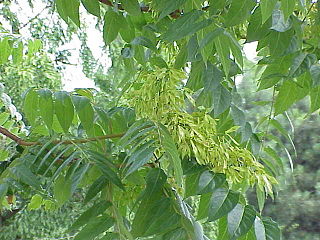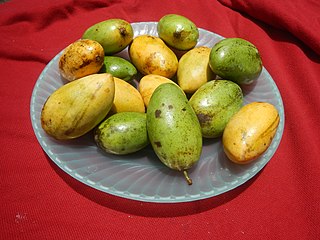
Ailanthus altissima, commonly known as tree of heaven, ghetto palm, Ailanthus, varnish tree, copal tree, stinking sumac, Chinese sumac, paradise tree, or in Chinese as chouchun, is a deciduous tree in the family Simaroubaceae. It is native to northeast and central China, and Taiwan. Unlike other members of the genus Ailanthus, it is found in temperate climates rather than the tropics.

The Simaroubaceae are a small, mostly tropical, family in the order Sapindales. In recent decades, it has been subject to much taxonomic debate, with several small families being split off. A molecular phylogeny of the family was published in 2007, greatly clarifying relationships within the family. Together with chemical characteristics such as the occurrence of petroselinic acid in Picrasma, in contrast to other members of the family such as Ailanthus, this indicates the existence of a subgroup in the family with Picrasma, Holacantha, and Castela.

Festuca (fescue) is a genus of flowering plants belonging to the grass family Poaceae. They are evergreen or herbaceous perennial tufted grasses with a height range of 10–200 cm (4–79 in) and a cosmopolitan distribution, occurring on every continent except Antarctica. The genus is closely related to ryegrass (Lolium), and recent evidence from phylogenetic studies using DNA sequencing of plant mitochondrial DNA shows that the genus lacks monophyly. As a result, plant taxonomists have moved several species, including the forage grasses tall fescue and meadow fescue, from the genus Festuca into the genus Lolium, or alternatively into the segregate genus Schedonorus.

Ageratina altissima, also known as white snakeroot, richweed, or white sanicle, is a poisonous perennial herb in the family Asteraceae, native to eastern and central North America. An older binomial name for this species is Eupatorium rugosum, but the genus Eupatorium has undergone taxonomic revision by botanists, and some species once included in it have been moved to other genera.

Deschampsia cespitosa, commonly known as tufted hairgrass or tussock grass, is a perennial tufted plant in the grass family Poaceae. The distribution of this species is widespread, with it being native to North America, Central Africa, eastern Australia and Eurasia and being introduced to South Africa, South Australia and South America.

Festuca altaica, also known as the altai fescue, or the northern rough fescue, is a perennial bunchgrass with a wide native distribution in the Arctic, from central Asia to eastern North America. It was first described in 1829 by Carl Bernhard von Trinius. It is under the synonym F. scabrella, the rough fescue.
NVC community W8 is one of the woodland communities in the British National Vegetation Classification system. It is one of the six communities falling in the "mixed deciduous and oak/birch woodlands" group.

Mangifera altissima, is a species of mango native to the Philippines and surrounding regions in Indonesia, Malaysia, Papua New Guinea and the Solomon Islands. It is not grown commercially but is harvested from the wild in the Philippines. It has small fruits that are pale yellow when ripe and are very sweet, though much more fibrous than commercially cultivated Mangifera indica species like Carabao mangoes. It is threatened by habitat loss.

Festuca idahoensis is a species of grass known by the common names Idaho fescue and blue bunchgrass. It is native to western North America, where it is widespread and common. It can be found in many ecosystems, from shady forests to open plains grasslands.

Festuca incurva is a species of flowering plant in the family Poaceae, native from the Mediterranean to Central Asia and Pakistan. When placed in the monotypic genus Psilurus as Psilurus incurvus, it was the only species.

Festuca orientalis is a species of flowering plant in the family Poaceae, native to Morocco, West and Central Asia to Pakistan. It was first described in 1794 as Triticum subulatum. As the epithet subulata was already in use for Festuca subulata, the epithet orientalis was adopted when the species was transferred to the genus Festuca. This epithet was first used in 1846 for Nardurus orientalis, the basionym of the present name. Under the synonyms Loliolum orientale or Loliolum subulatum, it was the only species in the genus Loliolum.

Solidago altissima, the tall goldenrod or late goldenrod, is a North American species of goldenrod in the family Asteraceae which is widespread across much of Canada, the United States, and northern Mexico. It is common in much of its range and fairly tolerant of landscapes which have been disturbed by humans. It has become naturalized in many parts of the world.
Festuca floribunda is a species of flowering plant in the grass family Poaceae, native to western South America. When placed in the monotypic genus Dielsiochloa as Dielsiochloa floribunda, it was the only species.
Festuca salzmannii is a species of flowering plant in the family Poaceae (grasses), native to the Mediterranean from Spain to Cyprus, and to Turkey. It has been placed in the genus Narduroides as the sole species Narduroides salzmannii.

Elachista apicipunctella is a moth of the family Elachistidae found in Europe. It is found in all of Europe, east into northern Russia.

Elachista adscitella is a moth of the family Elachistidae found in Europe.

Lolium giganteum, giant fescue, is a woodland grass that grows on neutral to base-rich soils, often near streams or other damp places. It is native to Europe and much of Asia and has been introduced to parts of North America.

Festuca valesiaca, the Volga fescue, is a species of flowering plant in the family Poaceae. It is native to Europe and Asia. It was introduced to North America when it was deliberately planted. There it can be found in such US states as Arizona, Kansas, Montana, Vermont and Wyoming.

Hemarthria altissima, variously called limpo grass, limpograss, halt grass, Batavian quick grass, swamp couch grass, red swamp grass and red vleigrass, is a species of flowering plant in the jointgrass genus Hemarthria, family Poaceae. It is native to the Old World Tropics and Subtropics; Africa, Southern Europe, the Middle East, India, Southeast Asia, eastern China, and Borneo, and widely introduced as a forage in the New World, from Texas and Florida south to northern Argentina. In addition to being a valued forage for livestock, it makes a good, fragrant silage. A number of cultivars are commercially available.

Mansonia altissima is a species of tree native to western and Central Africa. It has the vernacular names of; African black walnut or African walnut.
















